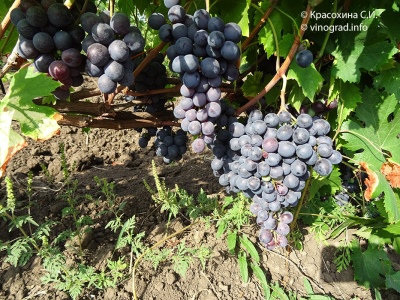
- Authors: France
- Appointment: universal
- Berry color: Navy blue
- With bones: Yes
- Ripening period: mid-late
- Ripening period, days: 148
- Frost resistance, ° C: -19
- Name synonyms: Sensation, Bastardillo Serrano, Black Malvasia, Black Prince, Kara Takopulo, Mavro Kara, Madiran, Malaga, Ottavionello, Passaril, Picardan (noir), Prunella
- Bunch weight, g: 154-210
- Flower type: bisexual
Bullseye is a grape variety that has been found in the vastness of our country for a long time. This variety grows especially well in the south, because it loves warmth. To get a stable harvest, you should know the features of agricultural technology.
Breeding history
As such, the history of breeding the variety has not been preserved, it is known that it spread throughout the world from France.
Geography of distribution
Today Bullseye grows with success both in the Urals and in the south and even in the Moscow region. All thanks to its resistance to slight frosts.
Description
If we talk about the purpose of the variety, then it is a universal grape. It can be used both fresh and prepared from berries compotes, wine.
In France, Bullseye is widely used to produce amazingly aromatic wine. Bushes can grow really big. The length of the vine sometimes reaches 4 meters. You can identify the variety by large, dark foliage.
Ripening period
From the moment the buds appear to harvest, 148 days pass. Bullseye is a medium late variety.
Bunches
Each bunch has a conical shape. The density of the berries is high. By weight, the bunches can reach from 154 to 210 grams. Slight peas may be observed under certain conditions.
Berries
The fruits of the described variety have a dark blue hue. The berries contain seeds, about 2-4 pieces per grape.
The skin is elastic, easy to tear, has a medium density. The weight of each fruit can reach from 2.6 to 3.4 g. If we talk about the tasting score, then it is at the level of 8-8.6 points.
Taste
The bullseye is praised for its fleshy flesh, juiciness and light crunch. Winemakers have come to love the variety for its distinctive aroma.
Yield
The bull's eye is a high-yielding plant. If you provide the vine with proper care, then you can collect up to 20 kilograms of berries from the bush.
Already in the first year after planting, young shoots reach the necessary maturity to produce crops. The fruits are harvested in September.


Growing features
Before planting, special attention is paid to the quality of the site. It should not only be well lit, but also be located where there is no draft.
Before planting seedlings, the soil is preliminarily loosened and fertilized without fail. A decent harvest can be expected if the soil is light and fertile.
Landing
The southern slope is ideal for planting, as it snows faster and the ground warms up earlier. The variety does not tolerate dampness, like most other plants of this type.
For planting, a special pit is prepared, inside which high-quality drainage is organized. The seedlings are immersed in the ground up to the root collar. After planting, the soil is moistened.
If you choose a shaded place for the grapes, the bushes will bear fruit, but their quality will deteriorate significantly. These grapes are small in size, pale in color, and sour.

Pollination
Bullseye does not require pollination, since flowers of both sexes are formed on the bush.
Pruning
The gardener should be especially careful about pruning, since the described variety refers to vigorous ones. Up to 5-8 eyes are left on the vine; there should be from 35 to 40 of them on the bush.

Watering
In order not to harm the plant, it is worth watering it with rainwater and it is desirable that it be warm. If you do not overmoisten the soil, the berry will turn out to be dense, elastic.


Top dressing
Fertilizer for grapes is essential. In order for a bush to form correctly and bring a stable harvest, it is necessary to provide it with 15 of the most important nutrients.
In the first year, the gardener cannot do without potassium and calcium. If the proportion is not observed, then the foliage will be large, and the clusters will be small.
With the growth of grapes, it is also fed with phosphorus. If it is not enough, then purple leaves are formed on the bush, which then quickly dry and fall off the vine.
It is good to feed the Bullseye with horse manure, bird droppings or wood ash. More efficiency can be achieved if all three components are mixed.
In summer, potassium sulfate is introduced into the soil as a fertilizer, which is easy to dissolve in water. This composition is quickly absorbed by the plant and has a positive effect.
Frost resistance and the need for shelter
The Bull's Eye has a frost resistance level of only -19 degrees. Thus, in the south it is not additionally covered, but in the Urals and in other regions it is covered with spruce branches, mulch or special material.

Diseases and pests
The variety has an average resistance to pests and diseases, therefore, it requires preventive treatment with fungicides, copper sulfate or Bordeaux liquid.

If a grape is exposed to any disease or insect, this always affects its appearance.
Storage
The grapes are well stored and transported over long distances. It can lie in the warehouse under proper conditions for up to 90 days without damage to the presentation.











































































